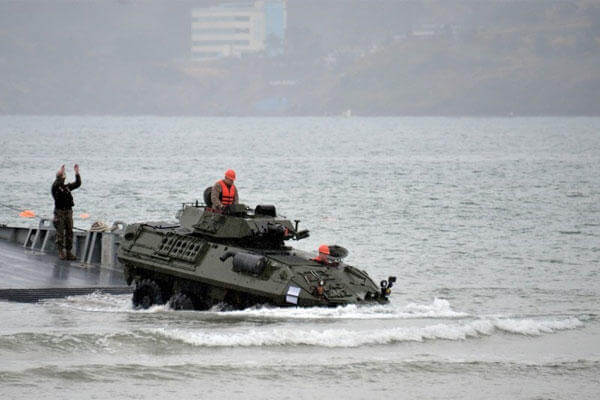Ship-to-shore operations date back centuries for Marines—from their first amphibious landing on the shores of the Bahamas in 1776 to operations today in the Persian Gulf, Pacific and other locations around the world.
It takes planning to move Marines and their systems from operations aboard Navy ships directly into operations ashore. Fittingly, Marine Corps Systems Command has a dedicated team for the mission.
“At any one time we have about 29 or so Navy amphibious ships with the mission of delivering Marines from ship to shore,” said Dave Lobik, head of the Joint Integration and Transportability Branch in MCSC’s Systems Engineering Interoperability Architectures and Technology office until recently. “My branch is responsible for integrating Marine Corps systems and equipment aboard a ship. For the things we don’t physically integrate, we make sure they’re interoperable.”
Lobik’s team considers everything from the physical design of Marine Corps vehicle platforms to the operation of information technology systems. He said this helps them understand the limitations and capabilities of deploying from a ship.
Ideally, such considerations are taken into account when a Marine Corps platform is being designed, but there are times when the team has to work around a design that is already established.
“Take the [Mine Resistant Ambush-Protected vehicle]; it’s already designed and built,” Lobik said. “But it wasn’t built to deploy aboard ships. So if there is a critical need to deploy multiple MRAPs aboard ships, we may have to cut into the ship, or reconfigure the ship somehow. That’s extreme, but these are the types of things we discuss [with the Navy].”
The team conducts feasibility studies and analysis, which starts with the Marine Corps and MCSC, Lobik said. MCSC is the Department of the Navy’s systems command for Marine Corps ground weapon and information technology systems. It is also the Marine Corps commandant's agent for acquisition and sustainment of warfighting systems and equipment.
MCSC does not accomplish the mission alone. The Joint Integration and Transportability Branch works with other organizations to evaluate and coordinate ship-to-shore mission assets. Marines assigned to the Navy’s Program Executive Office-Ships within Naval Sea Systems Command assist Lobik’s team in making sure Marine Corps needs are considered.
“When the Marines embark on these different ships, how do we know that what they bring aboard is going to fit?” said Col. Dave Thompson, senior Marine advisor to PEO Ships. “How do we know whether the [command, control, communications, computers and intelligence] equipment is going to interface with the ship’s power, networks, etc.? Part of my responsibility is to ensure that if the [Navy] program offices have a question about the material the Marine Corps is bringing, I can either answer it or get them the answer.”
The Marine Corps, with the Army, is now developing the joint light tactical vehicle. Once the Corps determines its size and shape, Lobik and Thompson’s teams will help coordinate with the Navy to determine any limitations as to which ships the vehicle can embark upon.
Coordination takes place on many levels. Lobik’s team participates in multiple forums with the Navy’s Space and Naval Warfare Systems Command, Naval Sea Systems Command and Naval Air Systems Command to work through integration and interoperability issues. Members of Thompson’s team work with everyone from shipbuilding engineers and logisticians to the most senior levels of the Navy’s program executive office staffs.
When Navy ships are being designed and built, the Marine Corps is engaged throughout the acquisition process, along with representatives from Combat Development and Integration, to make sure the “Marine Corps voice is heard,” Thompson said.
Even more complicated are the timelines associated with building a piece of Marine Corps equipment, such as the JLTV, compared to building a Navy ship, Thompson said. The Marine Corps may take five to 10 years to field a weapon or tactical vehicle, whereas a ship may take 15 years from design to commissioning.
“When you consider the length of a ship’s life cycle, you have to expect that there will be changes made to the ship to accommodate new equipment,” Thompson said. “But you also have to expect that when the Marine Corps develops new equipment, we take into consideration the space claim and limitations of the ship as well.”
Together, the MCSC and Navy teams keep present and future warfighting assets in their sights to make them as effective as possible at sea and ashore.



























